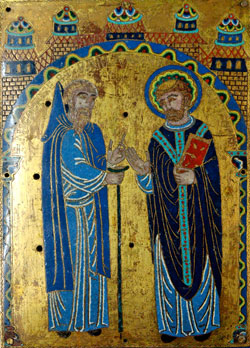
Feastday: February 8The early life of Stephen, a native of Thiers, France, is uncertain due to historical inaccuracies in the medieval biography of the saint. Nonetheless, his undertaking of consecrated life as a hermit is related in moving and convincing detail. Having built for himself a small hermitage on the mountain of Muret, Stephen vowed himself to God thus: "I, Stephen, renounce the devil and all his pomps, and offer myself to God the Father, Son, and Holy Spirit, the one true God in three Persons." He also prayed to the Blessed Virgin Mary, declaring, "Holy Mary, Mother of God, I commend my body, soul, and senses to your Son and to you." Thereafter, Stephen spent the next forty-eight years of his life in this wilderness, devoting himself to prayer and penitential self-denial. When on one occasion two papal legates visited him, they inquired as to whether he was a monk, a hermit, or a canon. He replied, "I am a sinner." Other men intending to imitate Stephen came to join him, so that the hermitage of Muret grew into a monastic community and a new religious congregation that would later be known as the Order of Grandmont.
Birth: 1046
Death: 1124
Canonized: 1189 by Pope Clement III
Stephen of Muret (French: Étienne de Muret) (1045 – February 8, 1124) was the founder of the Abbey of Grandmont (the mother house) and the Order of Grandmont.
Hagiography
Serious chronological difficulties are presented by the traditional story of his early life (printed in Patrologia Latina 204, coll. 1005-1072), which runs as follows: Stephen in his twelfth year accompanied his father, the Viscount of Thiers, to Italy, where he was left to be educated by Milo, Archbishop of Benevento; after passing twelve years in this prelate's household, he became acquainted with hermits in Calabria, but never joined their way of life. He then returned to France to bid farewell to his parents, having formed the design of entering religion, but, finding them dead, returned to Italy.
His patron Milo having also died, he established himself at Rome, where he studied the rules of the religious houses of the city. After a four years' sojourn he obtained a Bull from Gregory VII authorizing him to found an institute resembling that of the solitaries he had frequented in Calabria, and returned to France. He is said to have settled at Muret in 1076 and died at Muret on 8 February 1124. At Muret, he established the Order of Grandmont, a religious order of "extreme austerity and poverty."
This story is impossible; his father visited Italy in order to make a pilgrimage to St. Nicholas at Bari; but Nicholas's relics were not placed there till some years later; Milo was not Archbishop of Benevento for twelve years; the Gregory VII's bull is a forgery. The exact truth as to St. Stephen's life cannot now be established. However, the connexions with Milo, whose short episcopate (1074–75) would argue against any later invention by a biographer; the connexion, too, with Benevento, which held particular interest for reforming popes; and the lack of miracles during his life, would all argue for at least some details being historically sound. The Life would seem to have been originally written in the mid-twelfth century and to have been revised in the last decade of that century.
The quarrel as to what great order could claim Grandmont as its offspring, with the consequent forgeries, has done much to involve the founder's life in obscurity. Though Stephen was certainly the founder of the Order of Grandmont, he did little for his disciples except offer them the example of his holy life, and it was not till after his death that the order was firmly established.
Veneration
His head is preserved in the parish Church of St. Sylvestre, Canton of Laurière (in the Haute Vienne département).
He was canonized by Bishop Gerald II of Limoges in 1167 and by Pope Clement III in 1189. His liturgical feast occurs on 8 February.





